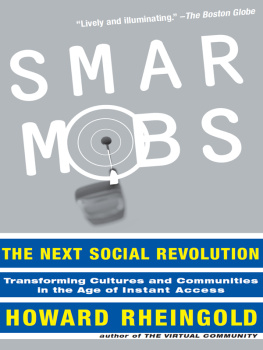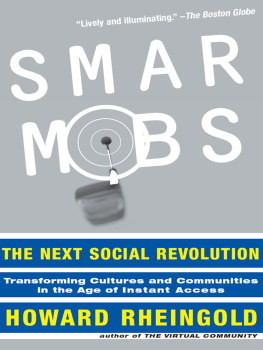Everyware
The dawning age of ubiquitous computing
Adam Greenfield
Everyware: The dawning age of ubiquitous computing
Adam Greenfield
New Riders
1249 Eighth Street
Berkeley, CA 94710
510/524-2178
800/283-9444
510/524-2221 (fax)
Published in association with AIGA
Find us on the Web at: www.newriders.com
To report errors, please send a note to
New Riders is an imprint of Peachpit, a division of Pearson Education
Copyright 2006 by Adam Greenfield
Project Editor: Michael J. Nolan
Development Editor: Dan Littman
Production Editor: Hilal Sala
Copyeditor: Alan Reade
Compositor: Joan Olson
Indexer: Karin Arrigoni
Cover design: Alicia Buelow
Interior design: Joan Olson
Notice of Rights
All rights reserved. No part of this book may be reproduced or transmitted in any form by any means, electronic, mechanical, photocopying, recording, or otherwise, without the prior written permission of the publisher. For information on getting permission for reprints and excerpts, contact .
Notice of Liability
The information in this book is distributed on an "As Is" basis without warranty. While every precaution has been taken in the preparation of the book, neither the author nor Peachpit shall have any liability to any person or entity with respect to any loss or damage caused or alleged to be caused directly or indirectly by the instructions contained in this book or by the computer software and hardware products described in it.
Trademarks
Many of the designations used by manufacturers and sellers to distinguish their products are claimed as trademarks. Where those designations appear in this book, and Peachpit was aware of a trademark claim, the designations appear as requested by the owner of the trademark. All other product names and services identified throughout this book are used in editorial fashion only and for the benefit of such companies with no intention of infringement of the trademark. No such use, or the use of any trade name, is intended to convey endorsement or other affiliation with this book.
ISBN 0-321-38401-6
9 8 7 6 5 4 3 2 1
Printed and bound in the United States of America
For Nurri, just like honey
They built the world as we know it...
All the systems you traverse.
The Fall, I Am Kurious Oranj
Introduction
This book is an attempt to describe the form computing will take in the next few years. Specifically, it's about a vision of processing power so distributed throughout the environment that computers per se effectively disappear. It's about the enormous consequences this disappearance has for the kinds of tasks computers are applied to, for the way we use them, and for what we understand them to be.
Although aspects of this vision have been called a variety of namesubiquitous computing, pervasive computing, physical computing, tangible media, and so onI think of them as facets of one coherent paradigm of interaction that I call everyware.
In everyware, all the information we now look to our phones or Web browsers to provide becomes accessible from just about anywhere, at any time, and is delivered in a manner appropriate to our location and context.
In everyware, the garment, the room and the street become sites of processing and mediation. Household objects from shower stalls to coffee pots are reimagined as places where facts about the world can be gathered, considered, and acted upon. And all the familiar rituals of daily lifethings as fundamental as the way we wake up in the morning, get to work, or shop for our groceriesare remade as an intricate dance of information about ourselves, the state of the external world, and the options available to us at any given moment.
In all of these scenarios, there are powerful informatics underlying the apparent simplicity of the experience, but they never breach the surface of awareness: things Just Work. Interactions with everyware feel natural, spontaneous, human. Ordinary people finally get to benefit from the full power of information technology, without having to absorb the esoteric bodies of knowledge on which it depends. And the sensation of useeven while managing an unceasing and torrential flow of datais one of calm, of relaxed mastery.
This, anyway, is the promise.
The appeal of all this is easy to understand. Who wouldn't desire a technology that promised to smooth the edges of modern life, subtly intervene on our behalf to guide us when we're lost, and remind us of the things we've forgotten? Who could object to one that dispensed with the clutter of computers and other digital devices we live with, even while doing all the things they do better?
The vision is a lovely one: deeply humane, even compassionate. But getting from here to there may prove difficult. Whatever improvement we hope to achieve by overlaying our lives with digital mediation, we'll have to balance against the risk of unduly complicating that which is presently straightforward, breaking that which now works, and introducing new levels of frustration and inconvenience into all the most basic operations of our lives.
We will have to account for what happens when such mediation breaks downas it surely will from time to time, given its origins in the same institutions, and the same development methodologies, that brought us unreliable mobile phone connections, mandatory annual operating system upgrades, and the Blue Screen of Death.
We will have to accept that privacy as we have understood it may become a thing of the past: that we will be presented the option of trading away access to the most intimate details of our lives in return for increased convenience, and that many of us will accept.
And we will have to reckon with the emergent aspects of our encounter with everyware, with all the ways in which its impact turns out to be something unforeseeably more than the sum of its parts.
What we can already see is this: everyware will surface and make explicit facts about our world that perhaps we would be happier ignoring. In countless ways, it will disturb unwritten agreements about workspace and homespace, the presentation of self and the right to privacy. It contains an inherent, unsettling potential for panoptical surveillance, regulation, and "rationalization." Its presence in our lives will transfigure our notions of space and time, self and other, citizen and society in ways that we haven't begun to contemplate.
If we pay close attention to all of these repercussions, we may conclude that everyware is something that should be approached with an unusual degree of caremore so because, on balance, we're just not very good at doing "smart." As a culture, we have so far been unable to craft high-technological artifacts that embody an understanding of the subtlety and richness of everyday life. And yet in everyware we're proposing to remake the very relations that define our lives, remodeling them on a technical paradigm nobody seems particularly satisfied with. A close reading of the existing literature on ubiquitous and pervasive systems is all that is necessary to feel the dissonance, to trip over the odd dislocations that crop up whenever we follow old maps into a new territory. We become acutely aware of our need for a more sensitive description of the terrain.
We will surely need one, at any rate, if we are to make sense of the wave of change even now bearing down on us. And we will feel this need in short order, because whether we're ready for it or not, everyware is coming.
It is coming because there are too many too powerful institutions vested in its coming, knowing what enormous market possibilities are opened up by the conquest of the everyday. It is coming because it is an irresistible, "technically sweet" challenge, for designers no less than engineers. It is coming because something like it effectively became inevitable the moment our tools, products and services started communicating in ones and zeroes.












